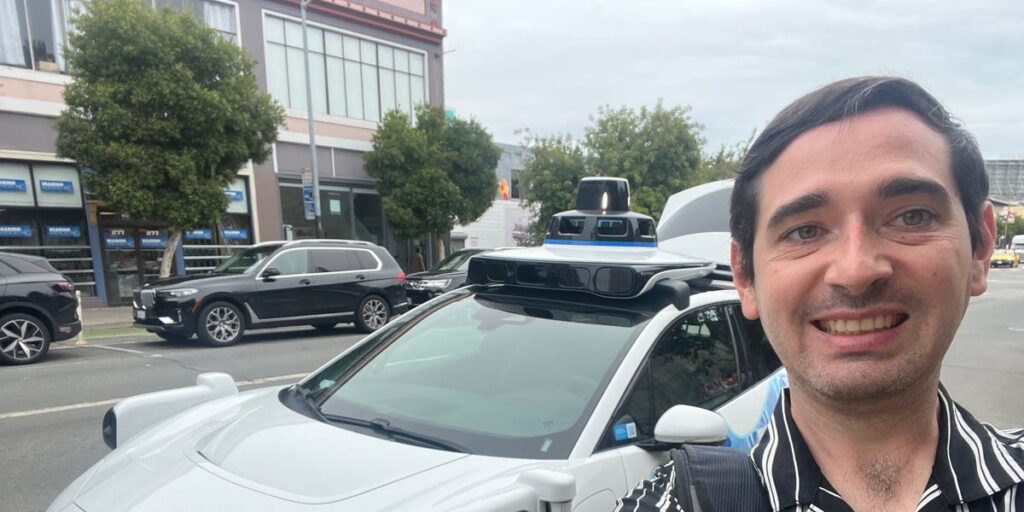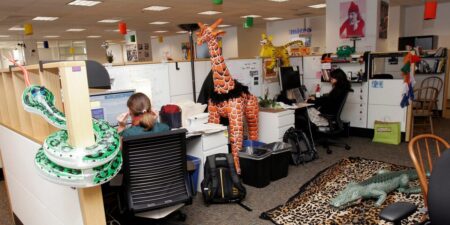X
Bluesky
Copy link
Impact Link
Save
Saved
Read in app
subscribers. Become an Insider
and start reading now.
Have an account? .
- Driverless cars are spreading to more US cities.
- Many are run by Waymo, both directly and through a partnership with Uber.
- I hailed a ride in a Waymo car in San Francisco to see what it’s like.
Robotaxis are becoming common in some big US cities, but they’re still novelties in many.
In Atlanta and Austin, for instance, companies like Uber and Lyft started offering rides in driverless cars earlier this year, but some riders have told me they’ve had to go out of their way to hail one. Where I live, in Washington, DC, you can spot self-driving cars on the road — Google’s Waymo, for one, is testing them in the market — but they’re not yet available to customers.
In San Francisco, meanwhile, self-driving cars are everywhere.
On a trip there last week, I couldn’t walk around the areas like Union Square and Market Street in the city center without seeing a car drive by without anyone at the wheel.
It was a strange sight for me, but I shouldn’t have been surprised. Waymo has been operating driverless rides in San Francisco since 2022, and the company opened the service up to anyone who downloads its app in the city last year.
After days of seeing robotaxis pass me on the street, I decided to hail a Waymo car and see what it’s like to ride one in a city where they’ve become so ubiquitous. Here’s what I found.
I used Waymo while getting around San Francisco for business.
I wanted to get from my hotel near Union Square to a meeting about 12 minutes away, so I pulled out my phone to check availability and prices.
A 12-minute ride was about $16 on Waymo.
I was traveling close to 9:30 a.m., so I expected to hit rush-hour traffic and see higher prices than if I had waited until later in the day.
It was a little more expensive than the same trip on Uber or Lyft.
Despite not having a human driver to pay, Waymo charged me more than Uber or Lyft would have for the same trip.
After booking with Waymo, I pulled up the two other ride-hailing services to compare prices. An UberX ride would have cost around $13, while Lyft, which was running a discount when I checked, would have charged about $10.
With a 20% tip, the Uber ride would have cost about the same as Waymo, but the Lyft ride would’ve been a few dollars cheaper.
A Waymo spokesperson said that the company looks at multiple factors when pricing rides, such as the trip’s duration and distance. “During busier times, such as morning rush hour and weekends, prices may be higher,” the spokesperson said.
As I waited, I saw several other Waymo vehicles drive by.
Self-driving cars, especially ones operated by Waymo, are everywhere in the center of San Francisco.
During the six-minute wait for my ride, I noticed at least a half-dozen other Waymo vehicles drive by, including two right next to each other. Going around town over the previous couple of days, I found out how hard it was to even walk around a city block without seeing at least one or two self-driving cars.
My car arrived, but I had to look twice to find it.
I initially missed the notification that my car had arrived. As I looked around my pickup location, though, I couldn’t see a Waymo stopped near me.
After checking the map, I realized that it had stopped down the block and up another street. While it took less than a minute to walk there, I wondered why the car had not navigated to my designated pick-up point. Waymo declined to comment on the trip.
After going down the block, I found this Waymo vehicle waiting for me.
I knew that this was my car from the license plate, which was on-screen in the Waymo app. My initials were also visible on the console that was on the roof.
Three other Waymo-run cars were stopped behind it.
The street where my car stopped wasn’t as busy as the one I waited on, which might explain why it was there.
I found it funny that there were three other Waymo cars stopped behind it.
I threw my bags in the trunk, got in the car, and started my trip.
I had to slide this button forward in the Waymo app to indicate I was ready to leave.
A safety video played as the car pulled away.
Sitting in the back of the electric Jaguar I-Pace, I noticed a screen on the console between the two front seats.
As the car started moving, a safety video started playing. It reminded me to buckle my seatbelt and said that I shouldn’t touch the steering wheel or the pedals.
Being in a car without a human driver wasn’t as creepy as I expected.
Some people I know swear that they’ll never get in one of these cars because no one is behind the wheel. I didn’t find it that strange, in part because I was traveling along city streets at low speeds.
Still, I couldn’t help but take a video of the empty driver’s seat, especially as the car made a turn and the wheel rotated without anyone present.
The screens in the Waymo showed some of the process behind the company’s self-driving tech.
At one point, the car stopped in the middle of an intersection.
As I tried to look ahead and see what was happening, I noticed that the screen in the front of the car laid out the situation for me: Someone was crossing the street one vehicle ahead, and the car I was in had noticed and stopped.
I could adjust the music, air conditioning, and other aspects of the ride through this screen.
The screen between the front seats also allowed me to call support if there was an issue.
I arrived at my destination on time.
Fortunately, my destination was on a less-busy street than the one where I hailed the car, so it was able to pull up directly in front of my destination.
I grabbed my bags from the back and headed to my meeting.
As I got out, the Waymo app prompted me to leave a review and offered walking directions to my destination (which I didn’t need, in this case).
Overall, I’d take a ride with Waymo again, but I’ll be comparing prices with Uber and Lyft.
I felt safe riding in Waymo’s vehicle, and with the company’s expansion to other cities, I would try one again.
But I probably won’t pay a premium to ride in a Waymo again. If Uber and Lyft are cheaper, I’d likely take a ride with one of those services.
Do you have a story to share about self-driving cars, the gig economy, or a related topic? Reach out to this reporter at [email protected].
Read the full article here
















